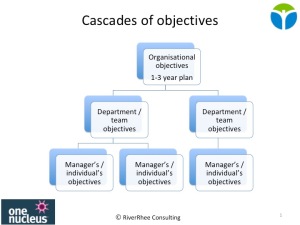By Elisabeth Goodman, 25th September 2019
We are entering that time of year when many companies carry out their performance reviews and appraisals. It can be quite a stressful exercise for individual team members, and for line managers.
This article from the latest issue of Harvard Business Review provides some interesting insights that could be relevant at the level of individual objectives, as well as at the level of team and organisational objectives.

Michael Harris and Bill Tayler. Don’t let metrics undermine your business. Harvard Business Review, September- October 2019, pp. 62-69
Performance measures operate on at least three levels in any organisation
We encourage delegates on RiverRhee’s management and Performance Review and Development courses to consider this three-tier cascade when setting their own and their direct reports’ objectives.

Ideally, the cascade works both downwards and upwards.
The process begins with clarity on the organisation’s current goals or objectives, and also with the individual’s ideas for work-related and personal- or career- development objectives.
The team or middle management objectives sit in the middle: they translate the organisation’s objectives into what the team and its members will do to make these happen. They also act as a reality check on if and how individual team members’ objectives will help to deliver the company goals.
All three levels of objectives should ideally have performance measures to match. And the purpose of such measures should be at least three-fold:
- To monitor and encourage any adjustments to behaviours and activities throughout the year
- To provide feedback on performance to internal and external stakeholders at agreed times
- To enable reflection, capture and sharing of learnings and inform forward plans for the next year.
“Surrogation” can drive the wrong behaviours
Surrogation, as defined by Harris and Tayler, is “the tendency to confuse what’s being measured with the metric being used”.
To give an example: a service company has an objective to improve customer satisfaction by 20%. They use a customer satisfaction survey in which they ask customers to score how satisfied they are with the service provided on a scale where 1 is low and 10 is high. Last year their average result was 8 out of 10, so they are looking for straight 10 ratings this year!
In a surrogation scenario, the staff responsible for the collecting the feedback can be so focused on only receiving scores of 10 that they will ask customers to provide this rating, and even email or call them to ask them to reassess if they have not done so. I know this is true as I have experienced this after putting my car in for a service!
Surrogation can drive the wrong behaviours, and also cause unnecessary stress for the individuals involved.
So how can performance measures be used to drive the right behaviours?
The correct behaviour in the example above would be for the service staff to get feedback on the quality of the customer’s experience: what they were happy with, what could have been done even better, and to reflect that back into a continuous improvement scenario. This way, the quantitative metrics are really just a snapshot to summarise the feedback.
Harris and Tayler suggest three ways in which surrogation could be avoided at the organisational levels. This also translates at the team and individual level:
- Involve managers (or team members) in shaping the goals or objectives. This way they understand and are engaged with what the goals are seeking to achieve, rather than just being focused on the metrics.
- Keep a clear separation between metrics and financial rewards. Tying the two together makes the metric more visible than the underlying objective, thereby risking the kind of behaviour described in the example. People get frightened or anxious, rather than being open to learning and exploring positive alternatives to their actions and behaviours. We know that many companies have decided against using individual performance ratings for this reason.
- Use multiple metrics for measuring performance. The authors suggest that if people have to bear multiple metrics in mind, they are less likely to surrogate on each one.

How could you translate this approach into the approach for objectives and performance metrics in your organisation?
Here are a couple of suggestions based on what we see happening in Life Science organisations.
If the company objectives are very broad or vague e.g. make X amount of sales this year, think about what individual teams might do to deliver that outcome. It might involve innovation or continuous improvement around products, services, processes, customer relations, employee development.
If individuals or their managers are overly focused on whether or not people have met or exceeded the numeric targets in their objectives, reflect instead on what new knowledge has been gained, what tangible outcomes have been achieved, and the resultant impact on the business.
NOTES
Elisabeth Goodman is the Owner and Principal Consultant at RiverRhee Consulting., a consultancy that specialises in “creating exceptional managers and teams”, with a focus on the Life Sciences. (We support our clients through courses, workshops and personal one-to-one coaching.) Elisabeth founded RiverRhee Consulting in 2009, and prior to that had 25+ years’ experience in the Pharmaceutical Industry in line management and internal training and consultancy roles supporting Information Management and other business teams on a global basis. RiverRhee is a member-to-member training provider for One Nucleus.
Elisabeth is accredited in Change Management, in Lean Sigma, in Belbin Team Roles, MBTI (Myers Briggs Type Indicator) and is an NLP (NeuroLinguistic Programming) Practitioner. She is a member of CILIP (Chartered Institute for Library and Information Professionals) and of APM (Association for Project Management) in which she was a founding member of the Enabling Change SIG.